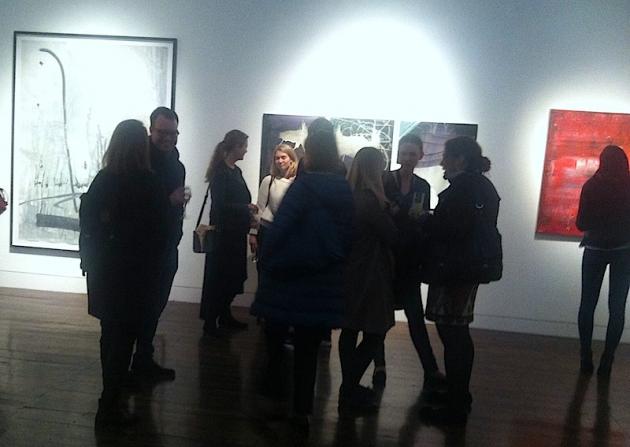When the co-curator of Christie’s historic new exhibition Polke/Richter-Richter/Polke, Darren Leak, wrote of his intentions to convey the two giants of the painting world’s “intimate dialogue”, nobody expected that to include the German pair taking a bath together – puckish, dripping, and youthful – or in bed, sharing an Antwerpian hotel room.
Those images were taken around the time of their legendary joint show at Hanover’s Galerie h in 1966, five years after they had met at Düsseldorf Art Academy, under the tutelage of the renowned Joseph Beuys. Both artists had fled East Germany prior to the erection of the Berlin Wall, and now sought to discover the radical “possibilities in painting”, in response to the bourgeois ideals that had emerged after the war, due to the wirtschaftswunder (“economic miracle”).
But this exhibition – although reuniting some of those paintings from half a century ago (Richter’s “Flemish Crown” and Polke’s “Bavarian”, 1965) – takes that period only as a premise, a starting point, and tracks how Richter and Polke spiralled apart, on vastly different stylistic trajectories. Or as Richter himself put it: “Polke drifted away into the psychedelic direction and I into the classical.” The resulting experience is more a vignette of two brilliant individuals, and their distinct innovations, than a comparative dialectic of their works, as intended.
Nonetheless, Polke/Richter-Richter/Polke sprawls over the three floors of Christie’s Mayfair and feels impressively expansive, incorporating 65 works from thirty collections around the world. The exhibition progresses chronologically from the mid-1960s: Polke’s Bavarian (1965) is one of his first raster dot paintings, a process that subversively mimics the mechanical production of the newspaper cover that he is depicting, while parodying American Pop art. Similarly, Richter’s Helen (1964) transforms a portrait of middle-class contentment into the sinister and saccharine, while his Stadtbild Ha (1968) is a minimalistic image of a haunting municipal structure.
As the exhibition sidles towards the 1980s, the paintings become more colourful and more abstract. Here, Polke outshines his emergent rival, following the pair’s gradually waning friendship over time. Polke’s Laterna Magica series (1988 – 96) is the highlight of the show: here we find experimentation with pigments, solvents, varnishes, toxins, resins, and the artist’s technique of painting on both sides of a canvas, evoking Cy Twombly and Joan Miro. Though Richter’s Kleine Strasse (1987) is a classic example of how his paintings look like photographs, his photographs like paintings. Now it seems a familiar riff on the arbitrariness of representation and reality; before him, it was not.
The latter work sees Richter delve more confidently into abstraction, and his Kind (1989) is probably the closest to his old friend’s style. Meanwhile, Polke brings a wonderful surreality with Untitled (1999), with suited figures morphing into pinstriped pencils; chaos across the canvas. It seems a fitting reflection of how since their early bond, Richter stayed close to home in Cologne, while Polke wandered the world, until his death in 2010.
Polke/Richter-Richter/Polke is not a holistic success, due to the implicit dichotomy of two such original, unique artists. But fortunately, its constituent parts are stimulating – and at times, brilliant – enough for that not to matter. Especially since Christie’s have had to contend with a significant Polke retrospective now on at MoMA New York and the largest ever show dedicated to Richter, next month at Fondation Beyeler in Switzerland. But ultimately, this show is not a critical watershed like its eponymous predecessor, it’s a satisfying homage.
Words/Top Photo Peter Yeung © Artlyst 2013
Polke/Richter-Richter/Polke Start: 25-04-2014 End: 07-07-2014Christie’s King Street London


